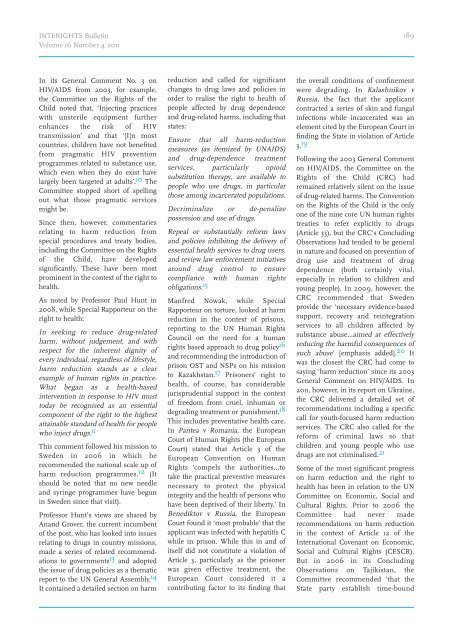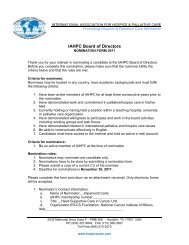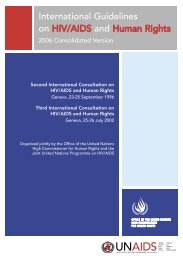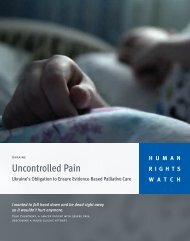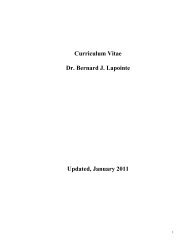INTERIGHTS Bulletin
INTERIGHTS Bulletin
INTERIGHTS Bulletin
You also want an ePaper? Increase the reach of your titles
YUMPU automatically turns print PDFs into web optimized ePapers that Google loves.
<strong>INTERIGHTS</strong> <strong>Bulletin</strong><br />
Volume 16 Number 4 2011<br />
189<br />
In its General Comment No. 3 on<br />
HIV/AIDS from 2003, for example,<br />
the Committee on the Rights of the<br />
Child noted that, ‘Injecting practices<br />
with unsterile equipment further<br />
enhances the risk of HIV<br />
transmission’ and that ‘[I]n most<br />
countries, children have not benefited<br />
from pragmatic HIV prevention<br />
programmes related to substance use,<br />
which even when they do exist have<br />
largely been targeted at adults’. 10 The<br />
Committee stopped short of spelling<br />
out what those pragmatic services<br />
might be.<br />
Since then, however, commentaries<br />
relating to harm reduction from<br />
special procedures and treaty bodies,<br />
including the Committee on the Rights<br />
of the Child, have developed<br />
significantly. These have been most<br />
prominent in the context of the right to<br />
health.<br />
As noted by Professor Paul Hunt in<br />
2008, while Special Rapporteur on the<br />
right to health:<br />
In seeking to reduce drug-related<br />
harm, without judgement, and with<br />
respect for the inherent dignity of<br />
every individual, regardless of lifestyle,<br />
harm reduction stands as a clear<br />
example of human rights in practice.<br />
What began as a health-based<br />
intervention in response to HIV must<br />
today be recognised as an essential<br />
component of the right to the highest<br />
attainable standard of health for people<br />
who inject drugs. 11<br />
This comment followed his mission to<br />
Sweden in 2006 in which he<br />
recommended the national scale up of<br />
harm reduction programmes. 12 (It<br />
should be noted that no new needle<br />
and syringe programmes have begun<br />
in Sweden since that visit).<br />
Professor Hunt’s views are shared by<br />
Anand Grover, the current incumbent<br />
of the post, who has looked into issues<br />
relating to drugs in country missions,<br />
made a series of related recommendations<br />
to governments 13 and adopted<br />
the issue of drug policies as a thematic<br />
report to the UN General Assembly. 14<br />
It contained a detailed section on harm<br />
reduction and called for significant<br />
changes to drug laws and policies in<br />
order to realise the right to health of<br />
people affected by drug dependence<br />
and drug-related harms, including that<br />
states:<br />
Ensure that all harm-reduction<br />
measures (as itemized by UNAIDS)<br />
and drug-dependence treatment<br />
services, particularly opioid<br />
substitution therapy, are available to<br />
people who use drugs, in particular<br />
those among incarcerated populations.<br />
Decriminalize or de-penalize<br />
possession and use of drugs.<br />
Repeal or substantially reform laws<br />
and policies inhibiting the delivery of<br />
essential health services to drug users,<br />
and review law enforcement initiatives<br />
around drug control to ensure<br />
compliance with human rights<br />
obligations. 15<br />
Manfred Nowak, while Special<br />
Rapporteur on torture, looked at harm<br />
reduction in the context of prisons,<br />
reporting to the UN Human Rights<br />
Council on the need for a human<br />
rights based approach to drug policy 16<br />
and recommending the introduction of<br />
prison OST and NSPs on his mission<br />
to Kazakhstan. 17 Prisoners’ right to<br />
health, of course, has considerable<br />
jurisprudential support in the context<br />
of freedom from cruel, inhuman or<br />
degrading treatment or punishment. 18<br />
This includes preventative health care.<br />
In Pantea v Romania, the European<br />
Court of Human Rights (the European<br />
Court) stated that Article 3 of the<br />
European Convention on Human<br />
Rights ‘compels the authorities...to<br />
take the practical preventive measures<br />
necessary to protect the physical<br />
integrity and the health of persons who<br />
have been deprived of their liberty.’ In<br />
Benediktov v Russia, the European<br />
Court found it ‘most probable’ that the<br />
applicant was infected with hepatitis C<br />
while in prison. While this in and of<br />
itself did not constitute a violation of<br />
Article 3, particularly as the prisoner<br />
was given effective treatment, the<br />
European Court considered it a<br />
contributing factor to its finding that<br />
the overall conditions of confinement<br />
were degrading. In Kalashnikov v<br />
Russia, the fact that the applicant<br />
contracted a series of skin and fungal<br />
infections while incarcerated was an<br />
element cited by the European Court in<br />
finding the State in violation of Article<br />
3. 19<br />
Following the 2003 General Comment<br />
on HIV/AIDS, the Committee on the<br />
Rights of the Child (CRC) had<br />
remained relatively silent on the issue<br />
of drug-related harms. The Convention<br />
on the Rights of the Child is the only<br />
one of the nine core UN human rights<br />
treaties to refer explicitly to drugs<br />
(Article 33), but the CRC’s Concluding<br />
Observations had tended to be general<br />
in nature and focused on prevention of<br />
drug use and treatment of drug<br />
dependence (both certainly vital,<br />
especially in relation to children and<br />
young people). In 2009, however, the<br />
CRC recommended that Sweden<br />
provide the ‘necessary evidence-based<br />
support, recovery and reintegration<br />
services to all children affected by<br />
substance abuse…aimed at effectively<br />
reducing the harmful consequences of<br />
such abuse’ [emphasis added]. 20 It<br />
was the closest the CRC had come to<br />
saying ‘harm reduction’ since its 2003<br />
General Comment on HIV/AIDS. In<br />
2011, however, in its report on Ukraine,<br />
the CRC delivered a detailed set of<br />
recommendations including a specific<br />
call for youth-focused harm reduction<br />
services. The CRC also called for the<br />
reform of criminal laws so that<br />
children and young people who use<br />
drugs are not criminalised. 21<br />
Some of the most significant progress<br />
on harm reduction and the right to<br />
health has been in relation to the UN<br />
Committee on Economic, Social and<br />
Cultural Rights. Prior to 2006 the<br />
Committee had never made<br />
recommendations on harm reduction<br />
in the context of Article 12 of the<br />
International Covenant on Economic,<br />
Social and Cultural Rights (CESCR).<br />
But in 2006 in its Concluding<br />
Observations on Tajikistan, the<br />
Committee recommended ‘that the<br />
State party establish time-bound


